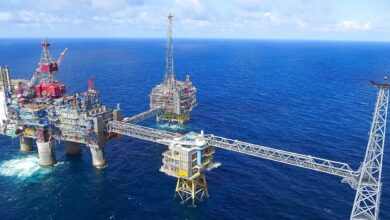New annular flow meter aims to prevent well control events before onset
By Alex Endress, Editorial Coordinator

The drilling industry places significant emphasis on figuring out how to handle well control events once they have been identified, but far less attention is given to avoiding well control situations before they occur. “We’re treating symptoms of well control after something has already happened,” Bob Judge, Director, Product Management, GE Oil & Gas, said at the IADC Drilling Engineers Committee Tech Forum on 7 September in Houston. “The fundamental problem is that it’s hard to measure what is coming out of the well and compare that to what we’re pumping into the well.” GE hopes to solve this problem with an annular flow meter, still under development, that can recognize trends in mud flow.
The annular flow meter has been designed to fit around drill pipe to monitor mud and flow characteristics in real time. “What we’re trying to do is accurately determine the change in flow coming out of the well,” Mr Judge said. “The idea here is how can I get something that’s as close to the source as I possibly can to give the driller a heads-up and give them a chance to react.”
GE began the development of the flow meter by assembling a group of scientists from the healthcare industry. The goal was to adapt technology that was being used to measure blood flow in human veins for the oilfield. “What we’ve done is arranged a number of ultrasonic transducers around a pipe so if there’s a pipe in hole or out of hole it’s still measuring flow rate,” Mr Judge said. One functionality specifically targeted was the ability to place the flow meter at the seabed. “We wanted to get rid of heavy noise, so if we put it there where it’s anchored, we can eliminate that heavy noise.” No major rig modifications are required to use the tool, he added.
To validate the technology, GE tested the meter at a flow-loop testing center in China using 1.5-in. pipe. This proved the device could successfully make flow readings outside of the pipe. The next step was to scale the device up to 18 ¾–in. diameter, and this test was conducted at a test rig site in Contessa, Okla. “We wanted to simulate mud circulation, tripping in and out,” he said. The Contessa test showed the flow meter could recognize complex drilling situations, such as when a kick could be coming on. “We measured flow rate and validated that with readings from a Coriolis meter.”
The flow meter could even be complementary to Coriolis meters, he said. “You can put that in conjunction with something that’s actually measuring something come out of the well, close to the well. This is above the BOP, so you can catch something while it is still in the well.”
The company is currently refining the tool’s precision and is looking to test the flow meter at a real drilling site. In the future, GE would also like to test reliability of the flow meter while placed on a drilling riser for subsea wells. “The progression of land to offshore and subsea is something we have to acknowledge, and it will take time to get there.”




